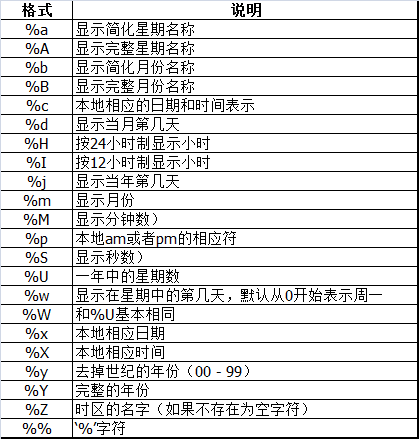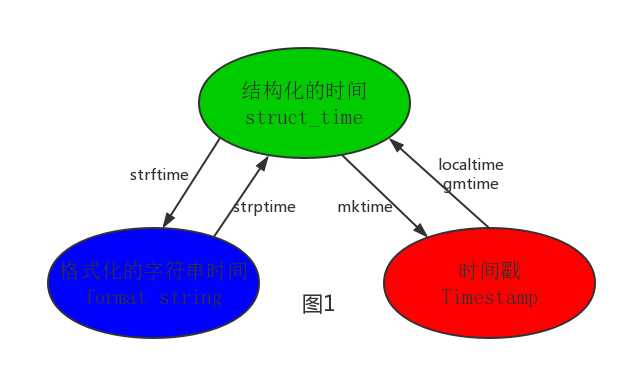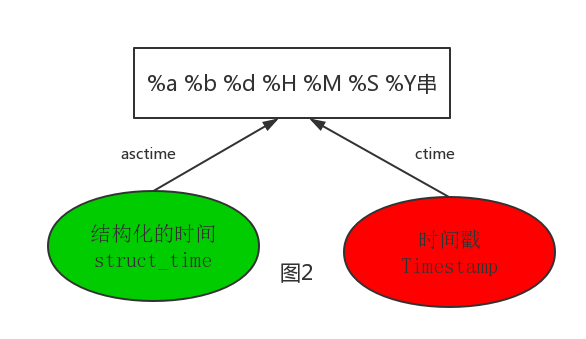常用模块
介绍
- time与datetime模块
- random模块
- os模块
- sys模块
- shutil模块
- json&pickle模块
- shelve模块
- xml模块
- configparser模块
- hashlib模块
- suprocess模块
- logging模块
- re模块
time与datetime时间模块
python 中时间表示方法有:时间戳,即从1975年1月1日00:00:00到现在的秒数;格式化后的时间字符串;时间struct_time 元组。
struct_time元组中元素主要包括tm_year(年)、tm_mon(月)、tm_mday(日)、tm_hour(时)、tm_min(分)、tm_sec(秒)、tm_wday(weekday0 - 6(0表示周日))、tm_yday(一年中的第几天1 - 366)、tm_isdst(是否是夏令时)
1.time
常用函数 time.time() 返回当前时间戳 import time >>> time.time() 1465370844.096474
#time.ctime() 返回这种格式的时间字符'Wed Jun 8 15:27:48 2016',显示当前时间.同时也可以转换时间戳 >>> time.ctime() Wed Jan 17 18:50:22 2018 >>> time.ctime(time.time()-86400) #计算昨天的时间 Tue Jan 16 18:50:58 2018
#time.gmtime 将时间戳转换成struct_time格式,此显示的是格林威治0时区的时间 >>> time.gmtime() time.struct_time(tm_year=2018, tm_mon=1, tm_mday=17, tm_hour=10, tm_min=53, tm_sec=7, tm_wday=2, tm_yday=17, tm_isdst=0) >>> time.gmtime(time.time() - 86400) time.struct_time(tm_year=2018, tm_mon=1, tm_mday=16, tm_hour=10, tm_min=52, tm_sec=22, tm_wday=1, tm_yday=16, tm_isdst=0)
#time.mktime 将struct_time格式转回成时间戳 now = time.localtime() print(now) print(time.mktime(time.localtime())) time.struct_time(tm_year=2018, tm_mon=1, tm_mday=17, tm_hour=18, tm_min=55, tm_sec=18, tm_wday=2, tm_yday=17, tm_isdst=0) 1516186518.0
#time.strftime 将struct_time格式转成指定的字符串格式 # now = time.localtime() # last = time.localtime(time.time() - 86400) # print(time.strftime("%Y-%m-%d %H:%M:%S",last)) 格式化成昨天 # 2018-01-16 18:57:27 # print(time.strftime("%Y-%m-%d %H:%M:%S",now)) 格式化成今天的时间 # 2018-01-17 18:57:27 # print(time.localtime()) # ime.struct_time(tm_year=2018, tm_mon=1, tm_mday=17, tm_hour=18, tm_min=58, tm_sec=15, tm_wday=2, tm_yday=17, tm_isdst=0)
#time.strptime 将自定义时间格式的字符串转换为struct_time格式 >>> time.strptime("2016-06-08","%Y-%m-%d") time.struct_time(tm_year=2016, tm_mon=6, tm_mday=8, tm_hour=0, tm_min=0, tm_sec=0, tm_wday=2, tm_yday=160, tm_isdst=-1) >>> time.strptime("2016-06-08 15:50:44","%Y-%m-%d %H:%M:%S") time.struct_time(tm_year=2016, tm_mon=6, tm_mday=8, tm_hour=15, tm_min=50, tm_sec=44, tm_wday=2, tm_yday=160, tm_isdst=-1)
- time.sleep 暂停时间,类似于shell的sleep()
- 时间格式

计算机认识的时间只能是'时间戳'格式,而程序员可处理的或者说人类能看懂的时间有: '格式化的时间字符串','结构化的时间' ,于是有了下图的转换关系


2.datetime

#datime是time的升级版,可以对date(日期)、time(时间)、datetime(日期时间)等三种单独管理。主要是由下面四个类组成 import datetime # print(datetime.datetime.now()) #返回 2016-08-19 12:47:03.941925 #print(datetime.date.fromtimestamp(time.time()) ) # 时间戳直接转成日期格式 2016-08-19 # print(datetime.datetime.now() ) # print(datetime.datetime.now() + datetime.timedelta(3)) #当前时间+3天 # print(datetime.datetime.now() + datetime.timedelta(-3)) #当前时间-3天 # print(datetime.datetime.now() + datetime.timedelta(hours=3)) #当前时间+3小时 # print(datetime.datetime.now() + datetime.timedelta(minutes=30)) #当前时间+30分 # # c_time = datetime.datetime.now() # print(c_time.replace(minute=3,hour=2)) #时间替换
Randon 模块
#random() 方法返回随机生成的一个实数,它在[0,1)范围内。 print(random.random())#(0,1)----float大于0且小于1之间的小数 print(random.randint(1,3))#[1,3]大于等于1且小于等于3之间的整数 print(random.randrange(1,3))#[1,3)大于等于1且小于3之间的整数 print(random.choice([1,'23',[4,5]]))#1或者23或者[4,5] print(random.sample([1,'23',[4,5]],2))#列表元素任意2个组合 print(random.uniform(1,3))#大于1小于3的小数,如1.927109612082716

#实用random 生成一个验证码 def make_code(n): res='' for i in range(n): s1=str(random.randint(0,9)) s2=chr(random.randint(65,90)) #生成的是二进制的a-z 的字符 res+=random.choice([s1,s2]) return res print(make_code(8))
Os 模块

#os模块是与操作系统交互的一个接口 os.getcwd() 获取当前工作目录,即当前python脚本工作的目录路径 os.chdir("dirname") 改变当前脚本工作目录;相当于shell下cd os.curdir 返回当前目录: ('.') os.pardir 获取当前目录的父目录字符串名:('..') os.makedirs('dirname1/dirname2') 可生成多层递归目录 os.removedirs('dirname1') 若目录为空,则删除,并递归到上一级目录,如若也为空,则删除,依此类推 os.mkdir('dirname') 生成单级目录;相当于shell中mkdir dirname os.rmdir('dirname') 删除单级空目录,若目录不为空则无法删除,报错;相当于shell中rmdir dirname os.listdir('dirname') 列出指定目录下的所有文件和子目录,包括隐藏文件,并以列表方式打印 os.remove() 删除一个文件 os.rename("oldname","newname") 重命名文件/目录 os.stat('path/filename') 获取文件/目录信息 os.sep 输出操作系统特定的路径分隔符,win下为"\\",Linux下为"/" os.linesep 输出当前平台使用的行终止符,win下为"\t\n",Linux下为"\n" os.pathsep 输出用于分割文件路径的字符串 win下为;,Linux下为: os.name 输出字符串指示当前使用平台。win->'nt'; Linux->'posix' os.system("bash command") 运行shell命令,直接显示 os.environ 获取系统环境变量 os.path.abspath(path) 返回path规范化的绝对路径 os.path.split(path) 将path分割成目录和文件名二元组返回 os.path.dirname(path) 返回path的目录。其实就是os.path.split(path)的第一个元素 os.path.basename(path) 返回path最后的文件名。如何path以/或\结尾,那么就会返回空值。即os.path.split(path)的第二个元素 os.path.exists(path) 如果path存在,返回True;如果path不存在,返回False os.path.isabs(path) 如果path是绝对路径,返回True os.path.isfile(path) 如果path是一个存在的文件,返回True。否则返回False os.path.isdir(path) 如果path是一个存在的目录,则返回True。否则返回False os.path.join(path1[, path2[, ...]]) 将多个路径组合后返回,第一个绝对路径之前的参数将被忽略 os.path.getatime(path) 返回path所指向的文件或者目录的最后存取时间 os.path.getmtime(path) 返回path所指向的文件或者目录的最后修改时间 os.path.getsize(path) 返回path的大小
在Linux和Mac平台上,该函数会原样返回path,在windows平台上会将路径中所有字符转换为小写,并将所有斜杠转换为反斜杠。 >>> os.path.normcase('c:/windows\\system32\\') 'c:\\windows\\system32\\' 规范化路径,如..和/ >>> os.path.normpath('c://windows\\System32\\../Temp/') 'c:\\windows\\Temp' >>> a='/Users/jieli/test1/\\\a1/\\\\aa.py/../..' >>> print(os.path.normpath(a)) /Users/jieli/test1
os路径处理 #方式一:推荐使用 import os #具体应用 import os,sys possible_topdir = os.path.normpath(os.path.join( os.path.abspath(__file__), os.pardir, #上一级 os.pardir, os.pardir )) sys.path.insert(0,possible_topdir) or(或) BASE_DIR=os.path.normpath(os.path.join( os.path.abspath(__file__), '..', '..' )) print(BASE_DIR) #方式二:不推荐使用 os.path.dirname(os.path.dirname(os.path.dirname(os.path.abspath(__file__))))
SyS 模块
1 sys.argv 命令行参数List,第一个元素是程序本身路径 2 sys.exit(n) 退出程序,正常退出时exit(0) 3 sys.version 获取Python解释程序的版本信息 4 sys.maxint 最大的Int值 5 sys.path 返回模块的搜索路径,初始化时使用PYTHONPATH环境变量的值 6 sys.platform 返回操作系统平台名称

#=========知识储备========== #进度条的效果 [# ] [## ] [### ] [#### ] #指定宽度 print('[%-15s]' %'#') print('[%-15s]' %'##') print('[%-15s]' %'###') print('[%-15s]' %'####') #打印% print('%s%%' %(100)) #第二个%号代表取消第一个%的特殊意义 #可传参来控制宽度 print('[%%-%ds]' %50) #[%-50s] print(('[%%-%ds]' %50) %'#') print(('[%%-%ds]' %50) %'##') print(('[%%-%ds]' %50) %'###') #=========实现打印进度条函数========== import sys import time def progress(percent,width=50): if percent >= 1: percent=1 show_str=('[%%-%ds]' %width) %(int(width*percent)*'#') print('\r%s %d%%' %(show_str,int(100*percent)),file=sys.stdout,flush=True,end='') #=========应用========== data_size=1025 recv_size=0 while recv_size < data_size: time.sleep(0.1) #模拟数据的传输延迟 recv_size+=1024 #每次收1024 percent=recv_size/data_size #接收的比例 progress(percent,width=70) #进度条的宽度70
Shutil 模块
高级的 文件、文件夹、压缩包 处理模块
shutil.copyfileobj(fsrc, fdst[, length])
将文件内容拷贝到另一个文件中
1 import shutil 2 3 shutil.copyfileobj(open('old.xml','r'), open('new.xml', 'w'))
shutil.copyfile(src, dst) 拷贝文件 1 shutil.copyfile('f1.log', 'f2.log') #目标文件无需存在
shutil.copymode(src, dst) 仅拷贝权限。内容、组、用户均不变 1 shutil.copymode('f1.log', 'f2.log') #目标文件必须存在
shutil.copystat(src, dst) 仅拷贝状态的信息,包括:mode bits, atime, mtime, flags 1 shutil.copystat('f1.log', 'f2.log') #目标文件必须存在
shutil.copy(src, dst) 拷贝文件和权限 1 import shutil 2 3 shutil.copy('f1.log', 'f2.log')
shutil.copy2(src, dst) 拷贝文件和状态信息 1 import shutil 2 3 shutil.copy2('f1.log', 'f2.log')
shutil.ignore_patterns(*patterns) shutil.copytree(src, dst, symlinks=False, ignore=None) 递归的去拷贝文件夹 1 import shutil 2 3 shutil.copytree('folder1', 'folder2', ignore=shutil.ignore_patterns('*.pyc', 'tmp*')) #目标目录不能存在,注意对folder2目录父级目录要有可写权限,
ignore的意思是排除

import shutil shutil.copytree('f1', 'f2', symlinks=True, ignore=shutil.ignore_patterns('*.pyc', 'tmp*')) ''' 通常的拷贝都把软连接拷贝成硬链接,即对待软连接来说,创建新的文件 '''
shutil.rmtree(path[, ignore_errors[, onerror]]) 递归的去删除文件 1 import shutil 2 3 shutil.rmtree('folder1')
shutil.move(src, dst) 递归的去移动文件,它类似mv命令,其实就是重命名。 1 import shutil 2 3 shutil.move('folder1', 'folder3')
shutil.make_archive(base_name, format,...)
创建压缩包并返回文件路径,例如:zip、tar
创建压缩包并返回文件路径,例如:zip、tar
- base_name: 压缩包的文件名,也可以是压缩包的路径。只是文件名时,则保存至当前目录,否则保存至指定路径,
如 data_bak =>保存至当前路径
如:/tmp/data_bak =>保存至/tmp/ - format: 压缩包种类,“zip”, “tar”, “bztar”,“gztar”
- root_dir: 要压缩的文件夹路径(默认当前目录)
- owner: 用户,默认当前用户
- group: 组,默认当前组
- logger: 用于记录日志,通常是logging.Logger对象
1 #将 /data 下的文件打包放置当前程序目录 2 import shutil 3 ret = shutil.make_archive("data_bak", 'gztar', root_dir='/data') 4 5 6 #将 /data下的文件打包放置 /tmp/目录 7 import shutil 8 ret = shutil.make_archive("/tmp/data_bak", 'gztar', root_dir='/data')
shutil 对压缩包的处理是调用 ZipFile 和 TarFile 两个模块来进行的,详细:

import zipfile # 压缩 z = zipfile.ZipFile('laxi.zip', 'w') z.write('a.log') z.write('data.data') z.close() # 解压 z = zipfile.ZipFile('laxi.zip', 'r') z.extractall(path='.') z.close()

import tarfile # 压缩 >>> t=tarfile.open('/tmp/egon.tar','w') >>> t.add('/test1/a.py',arcname='a.bak') >>> t.add('/test1/b.py',arcname='b.bak') >>> t.close() # 解压 >>> t=tarfile.open('/tmp/egon.tar','r') >>> t.extractall('/egon') >>> t.close()
Josn与Pickle模块
之前我们学习过用eval内置方法可以将一个字符串转成python对象,不过,eval方法是有局限性的,对于普通的数据类型,json.loads和eval都能用,但遇到特殊类型的时候,eval就不管用了,所以eval的重点还是通常用来执行一个字符串表达式,并返回表达式的值。
1 import json 2 x="[null,true,false,1]" 3 print(eval(x)) #报错,无法解析null类型,而json就可以 4 print(json.loads(x))
序列化:我们把对象(变量)从内存中变成可存储或传输的过程称之为序列化,在Python中叫pickling,在其他语言中也被称之为serialization,marshalling,flattening等等,都是一个意思。
为什么序列化:
- 持久保存状态
- 跨平台数据交互

为什么要序列化? 1:持久保存状态 需知一个软件/程序的执行就在处理一系列状态的变化,在编程语言中,'状态'会以各种各样有结构的数据类型(也可简单的理解为变量)的形式被保存在内存中。 内存是无法永久保存数据的,当程序运行了一段时间,我们断电或者重启程序,内存中关于这个程序的之前一段时间的数据(有结构)都被清空了。 在断电或重启程序之前将程序当前内存中所有的数据都保存下来(保存到文件中),以便于下次程序执行能够从文件中载入之前的数据,然后继续执行,这就是序列化。 具体的来说,你玩使命召唤闯到了第13关,你保存游戏状态,关机走人,下次再玩,还能从上次的位置开始继续闯关。或如,虚拟机状态的挂起等。 2:跨平台数据交互 序列化之后,不仅可以把序列化后的内容写入磁盘,还可以通过网络传输到别的机器上,如果收发的双方约定好实用一种序列化的格式,那么便打破了平台/语言差异化带来的限制,实现了跨平台数据交互。 反过来,把变量内容从序列化的对象重新读到内存里称之为反序列化,即unpickling。
josn
如果我们要在不同的编程语言之间传递对象,就必须把对象序列化为标准格式,比如XML,但更好的方法是序列化为JSON,因为JSON表示出来就是一个字符串,可以被所有语言读取,
也可以方便地存储到磁盘或者通过网络传输。JSON不仅是标准格式,并且比XML更快,而且可以直接在Web页面中读取,非常方便。
JSON表示的对象就是标准的JavaScript语言的对象,JSON和Python内置的数据类型对应如下:


1 import json 2 3 dic={'name':'alvin','age':23,'sex':'male'} 4 print(type(dic))#<class 'dict'> 5 6 j=json.dumps(dic) 7 print(type(j))#<class 'str'> 8 9 10 f=open('序列化对象','w') 11 f.write(j) #-------------------等价于json.dump(dic,f) 12 f.close() 13 #-----------------------------反序列化<br> 14 import json 15 f=open('序列化对象') 16 data=json.loads(f.read())# 等价于data=json.load(f)
注意:

import json #dct="{'1':111}"#json 不认单引号 #dct=str({"1":111})#报错,因为生成的数据还是单引号:{'one': 1} dct='{"1":"111"}' print(json.loads(dct)) #conclusion: # 无论数据是怎样创建的,只要满足json格式,就可以json.loads出来,不一定非要dumps的数据才能loads
pickle(了解)
1 import pickle 2 3 dic={'name':'alvin','age':23,'sex':'male'} 4 5 print(type(dic))#<class 'dict'> 6 7 j=pickle.dumps(dic) 8 print(type(j))#<class 'bytes'> 9 10 11 f=open('序列化对象_pickle','wb')#注意是w是写入str,wb是写入bytes,j是'bytes' 12 f.write(j) #-------------------等价于pickle.dump(dic,f) 13 14 f.close() 15 #-------------------------反序列化 16 import pickle 17 f=open('序列化对象_pickle','rb') 18 19 data=pickle.loads(f.read())# 等价于data=pickle.load(f) 20 21 22 print(data['age']) Pickle的问题和所有其他编程语言特有的序列化问题一样,就是它只能用于Python,并且可能不同版本的Python彼此都不兼容,因此,只能用Pickle保存那些不重要的数据,
不能成功地反序列化也没关系。
Shelve 模块
shelve模块比pickle模块简单,只有一个open函数,返回类似字典的对象,可读可写;key必须为字符串,而值可以是python所支持的数据类型 复制代码 import shelve f=shelve.open(r'sheve.txt') # f['stu1_info']={'name':'egon','age':18,'hobby':['piao','smoking','drinking']} # f['stu2_info']={'name':'gangdan','age':53} # f['school_info']={'website':'http://www.pypy.org','city':'beijing'} print(f['stu1_info']['hobby']) f.close()
XML 模块
xml是实现不同语言或程序之间进行数据交换的协议,跟json差不多,但json使用起来更简单,不过,古时候,在json还没诞生的黑暗年代,大家只能选择用xml呀,至今很多传统公司
如金融行业的很多系统的接口还主要是xml。
xml的格式如下,就是通过<>节点来区别数据结构的:

<?xml version="1.0"?> <data> <country name="Liechtenstein"> <rank updated="yes">2</rank> <year>2008</year> <gdppc>141100</gdppc> <neighbor name="Austria" direction="E"/> <neighbor name="Switzerland" direction="W"/> </country> <country name="Singapore"> <rank updated="yes">5</rank> <year>2011</year> <gdppc>59900</gdppc> <neighbor name="Malaysia" direction="N"/> </country> <country name="Panama"> <rank updated="yes">69</rank> <year>2011</year> <gdppc>13600</gdppc> <neighbor name="Costa Rica" direction="W"/> <neighbor name="Colombia" direction="E"/> </country> </data> xml数据
xml协议在各个语言里的都 是支持的,在python中可以用以下模块操作xml: # print(root.iter('year')) #全文搜索 # print(root.find('country')) #在root的子节点找,只找一个 # print(root.findall('country')) #在root的子节点找,找所有

import xml.etree.ElementTree as ET tree = ET.parse("xmltest.xml") root = tree.getroot() print(root.tag) #遍历xml文档 for child in root: print('========>',child.tag,child.attrib,child.attrib['name']) for i in child: print(i.tag,i.attrib,i.text) #只遍历year 节点 for node in root.iter('year'): print(node.tag,node.text) #--------------------------------------- import xml.etree.ElementTree as ET tree = ET.parse("xmltest.xml") root = tree.getroot() #修改 for node in root.iter('year'): new_year=int(node.text)+1 node.text=str(new_year) node.set('updated','yes') node.set('version','1.0') tree.write('test.xml') #删除node for country in root.findall('country'): rank = int(country.find('rank').text) if rank > 50: root.remove(country) tree.write('output.xml') 复制代码 复制代码 #在country内添加(append)节点year2 import xml.etree.ElementTree as ET tree = ET.parse("a.xml") root=tree.getroot() for country in root.findall('country'): for year in country.findall('year'): if int(year.text) > 2000: year2=ET.Element('year2') year2.text='新年' year2.attrib={'update':'yes'} country.append(year2) #往country节点下添加子节点 tree.write('a.xml.swap') 复制代码
Configparser 模块
配置文件如下 # 注释1 ; 注释2 [section1] k1 = v1 k2:v2 user=egon age=18 is_admin=true salary=31 [section2] k1 = v1
读取 复制代码 import configparser config=configparser.ConfigParser() config.read('a.cfg') #查看所有的标题 res=config.sections() #['section1', 'section2'] print(res) #查看标题section1下所有key=value的key options=config.options('section1') print(options) #['k1', 'k2', 'user', 'age', 'is_admin', 'salary'] #查看标题section1下所有key=value的(key,value)格式 item_list=config.items('section1') print(item_list) #[('k1', 'v1'), ('k2', 'v2'), ('user', 'egon'), ('age', '18'), ('is_admin', 'true'), ('salary', '31')] #查看标题section1下user的值=>字符串格式 val=config.get('section1','user') print(val) #egon #查看标题section1下age的值=>整数格式 val1=config.getint('section1','age') print(val1) #18 #查看标题section1下is_admin的值=>布尔值格式 val2=config.getboolean('section1','is_admin') print(val2) #True #查看标题section1下salary的值=>浮点型格式 val3=config.getfloat('section1','salary') print(val3) #31.0
改写 复制代码 import configparser config=configparser.ConfigParser() config.read('a.cfg',encoding='utf-8') #删除整个标题section2 config.remove_section('section2') #删除标题section1下的某个k1和k2 config.remove_option('section1','k1') config.remove_option('section1','k2') #判断是否存在某个标题 print(config.has_section('section1')) #判断标题section1下是否有user print(config.has_option('section1','')) #添加一个标题 config.add_section('egon') #在标题egon下添加name=egon,age=18的配置 config.set('egon','name','egon') config.set('egon','age',18) #报错,必须是字符串 #最后将修改的内容写入文件,完成最终的修改 config.write(open('a.cfg','w'))

import configparser config = configparser.ConfigParser() config["DEFAULT"] = {'ServerAliveInterval': '45', 'Compression': 'yes', 'CompressionLevel': '9'} config['bitbucket.org'] = {} config['bitbucket.org']['User'] = 'hg' config['topsecret.server.com'] = {} topsecret = config['topsecret.server.com'] topsecret['Host Port'] = '50022' # mutates the parser topsecret['ForwardX11'] = 'no' # same here config['DEFAULT']['ForwardX11'] = 'yes' with open('example.ini', 'w') as configfile: config.write(configfile) 复制代码
Hashlib 模块
hash:一种算法 ,3.x里代替了md5模块和sha模块,主要提供 SHA1, SHA224, SHA256, SHA384, SHA512 ,MD5 算法 三个特点: 1.内容相同则hash运算结果相同,内容稍微改变则hash值则变 2.不可逆推 3.相同算法:无论校验多长的数据,得到的哈希值长度固定。
import hashlib 2 3 m=hashlib.md5()# m=hashlib.sha256() 4 5 m.update('hello'.encode('utf8')) 6 print(m.hexdigest()) #5d41402abc4b2a76b9719d911017c592 7 8 m.update('alvin'.encode('utf8')) 9 10 print(m.hexdigest()) #92a7e713c30abbb0319fa07da2a5c4af 11 12 m2=hashlib.md5() 13 m2.update('helloalvin'.encode('utf8')) 14 print(m2.hexdigest()) #92a7e713c30abbb0319fa07da2a5c4af 15 16 ''' 17 注意:把一段很长的数据update多次,与一次update这段长数据,得到的结果一样 18 但是update多次为校验大文件提供了可能。 19 '''
以上加密算法虽然依然非常厉害,但时候存在缺陷,即:通过撞库可以反解。所以,有必要对加密算法中添加自定义key再来做加密。 复制代码 1 import hashlib 2 3 # ######## 256 ######## 4 5 hash = hashlib.sha256('898oaFs09f'.encode('utf8')) 6 hash.update('alvin'.encode('utf8')) 7 print (hash.hexdigest())#e79e68f070cdedcfe63eaf1a2e92c83b4cfb1b5c6bc452d214c1b7e77cdfd1c7

import hashlib passwds=[ 'alex3714', 'alex1313', 'alex94139413', 'alex123456', '123456alex', 'a123lex', ] def make_passwd_dic(passwds): dic={} for passwd in passwds: m=hashlib.md5() m.update(passwd.encode('utf-8')) dic[passwd]=m.hexdigest() return dic def break_code(cryptograph,passwd_dic): for k,v in passwd_dic.items(): if v == cryptograph: print('密码是===>\033[46m%s\033[0m' %k) cryptograph='aee949757a2e698417463d47acac93df' break_code(cryptograph,make_passwd_dic(passwds))
python 还有一个 hmac 模块,它内部对我们创建 key 和 内容 进行进一步的处理然后再加密: 1 import hmac 2 h = hmac.new('alvin'.encode('utf8')) 3 h.update('hello'.encode('utf8')) 4 print (h.hexdigest())#320df9832eab4c038b6c1d7ed73a5940

#要想保证hmac最终结果一致,必须保证: #1:hmac.new括号内指定的初始key一样 #2:无论update多少次,校验的内容累加到一起是一样的内容 import hmac h1=hmac.new(b'egon') h1.update(b'hello') h1.update(b'world') print(h1.hexdigest()) h2=hmac.new(b'egon') h2.update(b'helloworld') print(h2.hexdigest()) h3=hmac.new(b'egonhelloworld') print(h3.hexdigest()) ''' f1bf38d054691688f89dcd34ac3c27f2 f1bf38d054691688f89dcd34ac3c27f2 bcca84edd9eeb86f30539922b28f3981 '''
Suprocess 模块

1 import subprocess 2 3 ''' 4 sh-3.2# ls /Users/egon/Desktop |grep txt$ 5 mysql.txt 6 tt.txt 7 事物.txt 8 ''' 9 10 res1=subprocess.Popen('ls /Users/jieli/Desktop',shell=True,stdout=subprocess.PIPE) 11 res=subprocess.Popen('grep txt$',shell=True,stdin=res1.stdout, 12 stdout=subprocess.PIPE) 13 14 print(res.stdout.read().decode('utf-8')) 15 16 17 #等同于上面,但是上面的优势在于,一个数据流可以和另外一个数据流交互,可以通过爬虫得到结果然后交给grep 18 res1=subprocess.Popen('ls /Users/jieli/Desktop |grep txt$',shell=True,stdout=subprocess.PIPE) 19 print(res1.stdout.read().decode('utf-8')) 20 21 22 #windows下: 23 # dir | findstr 'test*' 24 # dir | findstr 'txt$' 25 import subprocess 26 res1=subprocess.Popen(r'dir C:\Users\Administrator\PycharmProjects\test\函数备课',shell=True,stdout=subprocess.PIPE) 27 res=subprocess.Popen('findstr test*',shell=True,stdin=res1.stdout, 28 stdout=subprocess.PIPE) 29 30 print(res.stdout.read().decode('gbk')) #subprocess使用当前系统默认编码,得到结果为bytes类型,在windows下需要用gbk解码
Logging 模块
日志级别
CRITICAL = 50 #FATAL = CRITICAL ERROR = 40 WARNING = 30 #WARN = WARNING INFO = 20 DEBUG = 10 NOTSET = 0 #不设置 等于关闭日志功能
默认级别为warning,默认打印到终端
import logging logging.debug('调试debug') logging.info('消息info') logging.warning('警告warn') logging.error('错误error') logging.critical('严重critical') ''' WARNING:root:警告warn ERROR:root:错误error CRITICAL:root:严重critical
为logging模块指定全局配置,针对所有logger有效,控制打印到文件中

可在logging.basicConfig()函数中通过具体参数来更改logging模块默认行为,可用参数有 filename:用指定的文件名创建FiledHandler(后边会具体讲解handler的概念),这样日志会被存储在指定的文件中。 filemode:文件打开方式,在指定了filename时使用这个参数,默认值为“a”还可指定为“w”。 format:指定handler使用的日志显示格式。 datefmt:指定日期时间格式。 level:设置rootlogger(后边会讲解具体概念)的日志级别 stream:用指定的stream创建StreamHandler。可以指定输出到sys.stderr,sys.stdout或者文件,默认为sys.stderr。若同时列出了filename和stream两个参数,则stream参数会被忽略。 #格式 %(name)s:Logger的名字,并非用户名,详细查看 %(levelno)s:数字形式的日志级别 %(levelname)s:文本形式的日志级别 %(pathname)s:调用日志输出函数的模块的完整路径名,可能没有 %(filename)s:调用日志输出函数的模块的文件名 %(module)s:调用日志输出函数的模块名 %(funcName)s:调用日志输出函数的函数名 %(lineno)d:调用日志输出函数的语句所在的代码行 %(created)f:当前时间,用UNIX标准的表示时间的浮 点数表示 %(relativeCreated)d:输出日志信息时的,自Logger创建以 来的毫秒数 %(asctime)s:字符串形式的当前时间。默认格式是 “2003-07-08 16:49:45,896”。逗号后面的是毫秒 %(thread)d:线程ID。可能没有 %(threadName)s:线程名。可能没有 %(process)d:进程ID。可能没有 %(message)s:用户输出的消息

#======介绍 可在logging.basicConfig()函数中可通过具体参数来更改logging模块默认行为,可用参数有 filename:用指定的文件名创建FiledHandler(后边会具体讲解handler的概念),这样日志会被存储在指定的文件中。 filemode:文件打开方式,在指定了filename时使用这个参数,默认值为“a”还可指定为“w”。 format:指定handler使用的日志显示格式。 datefmt:指定日期时间格式。 level:设置rootlogger(后边会讲解具体概念)的日志级别 stream:用指定的stream创建StreamHandler。可以指定输出到sys.stderr,sys.stdout或者文件,默认为sys.stderr。若同时列出了filename和stream两个参数,则stream参数会被忽略。 format参数中可能用到的格式化串: %(name)s Logger的名字 %(levelno)s 数字形式的日志级别 %(levelname)s 文本形式的日志级别 %(pathname)s 调用日志输出函数的模块的完整路径名,可能没有 %(filename)s 调用日志输出函数的模块的文件名 %(module)s 调用日志输出函数的模块名 %(funcName)s 调用日志输出函数的函数名 %(lineno)d 调用日志输出函数的语句所在的代码行 %(created)f 当前时间,用UNIX标准的表示时间的浮 点数表示 %(relativeCreated)d 输出日志信息时的,自Logger创建以 来的毫秒数 %(asctime)s 字符串形式的当前时间。默认格式是 “2003-07-08 16:49:45,896”。逗号后面的是毫秒 %(thread)d 线程ID。可能没有 %(threadName)s 线程名。可能没有 %(process)d 进程ID。可能没有 %(message)s用户输出的消息 #========使用 import logging logging.basicConfig(filename='access.log', format='%(asctime)s - %(name)s - %(levelname)s -%(module)s: %(message)s', datefmt='%Y-%m-%d %H:%M:%S %p', level=10) logging.debug('调试debug') logging.info('消息info') logging.warning('警告warn') logging.error('错误error') logging.critical('严重critical') #========结果 access.log内容: 2017-07-28 20:32:17 PM - root - DEBUG -test: 调试debug 2017-07-28 20:32:17 PM - root - INFO -test: 消息info 2017-07-28 20:32:17 PM - root - WARNING -test: 警告warn 2017-07-28 20:32:17 PM - root - ERROR -test: 错误error 2017-07-28 20:32:17 PM - root - CRITICAL -test: 严重critical part2: 可以为logging模块指定模块级的配置,即所有logger的配置
logging模块的Formatter,Handler,Logger,Filter对象
#logger:产生日志的对象 #Filter:过滤日志的对象 #Handler:接收日志然后控制打印到不同的地方,FileHandler用来打印到文件中,StreamHandler用来打印到终端 #Formatter对象:可以定制不同的日志格式对象,然后绑定给不同的Handler对象使用,以此来控制不同的Handler的日志格式

''' critical=50 error =40 warning =30 info = 20 debug =10 ''' import logging #1、logger对象:负责产生日志,然后交给Filter过滤,然后交给不同的Handler输出 logger=logging.getLogger(__file__) #2、Filter对象:不常用,略 #3、Handler对象:接收logger传来的日志,然后控制输出 h1=logging.FileHandler('t1.log') #打印到文件 h2=logging.FileHandler('t2.log') #打印到文件 h3=logging.StreamHandler() #打印到终端 #4、Formatter对象:日志格式 formmater1=logging.Formatter('%(asctime)s - %(name)s - %(levelname)s -%(module)s: %(message)s', datefmt='%Y-%m-%d %H:%M:%S %p',) formmater2=logging.Formatter('%(asctime)s : %(message)s', datefmt='%Y-%m-%d %H:%M:%S %p',) formmater3=logging.Formatter('%(name)s %(message)s',) #5、为Handler对象绑定格式 h1.setFormatter(formmater1) h2.setFormatter(formmater2) h3.setFormatter(formmater3) #6、将Handler添加给logger并设置日志级别 logger.addHandler(h1) logger.addHandler(h2) logger.addHandler(h3) logger.setLevel(10) #7、测试 logger.debug('debug') logger.info('info') logger.warning('warning') logger.error('error') logger.critical('critical')
注意:
Logger与Handler的级别:
logger是第一级过滤,然后才能到handler,我们可以给logger和handler同时设置level,但是需要注意的是logger的级别一定要比handler的底。
应用

""" logging配置 """ import os import logging.config # 定义三种日志输出格式 开始 standard_format = '[%(asctime)s][%(threadName)s:%(thread)d][task_id:%(name)s][%(filename)s:%(lineno)d]' \ '[%(levelname)s][%(message)s]' #其中name为getlogger指定的名字 simple_format = '[%(levelname)s][%(asctime)s][%(filename)s:%(lineno)d]%(message)s' id_simple_format = '[%(levelname)s][%(asctime)s] %(message)s' # 定义日志输出格式 结束 logfile_dir = os.path.dirname(os.path.abspath(__file__)) # log文件的目录 logfile_name = 'all2.log' # log文件名 # 如果不存在定义的日志目录就创建一个 if not os.path.isdir(logfile_dir): os.mkdir(logfile_dir) # log文件的全路径 logfile_path = os.path.join(logfile_dir, logfile_name) # log配置字典 LOGGING_DIC = { 'version': 1, 'disable_existing_loggers': False, 'formatters': { 'standard': { 'format': standard_format }, 'simple': { 'format': simple_format }, }, 'filters': {}, 'handlers': { #打印到终端的日志 'console': { 'level': 'DEBUG', 'class': 'logging.StreamHandler', # 打印到屏幕 'formatter': 'simple' }, #打印到文件的日志,收集info及以上的日志 'default': { 'level': 'DEBUG', 'class': 'logging.handlers.RotatingFileHandler', # 保存到文件 'formatter': 'standard', 'filename': logfile_path, # 日志文件 'maxBytes': 1024*1024*5, # 日志大小 5M 'backupCount': 5, 'encoding': 'utf-8', # 日志文件的编码,再也不用担心中文log乱码了 }, }, 'loggers': { #logging.getLogger(__name__)拿到的logger配置 '': { 'handlers': ['default', 'console'], # 这里把上面定义的两个handler都加上,即log数据既写入文件又打印到屏幕 'level': 'DEBUG', 'propagate': True, # 向上(更高level的logger)传递 }, }, } def load_my_logging_cfg(): logging.config.dictConfig(LOGGING_DIC) # 导入上面定义的logging配置 logger = logging.getLogger(__name__) # 生成一个log实例 logger.info('It works!') # 记录该文件的运行状态 if __name__ == '__main__': load_my_logging_cfg()

""" MyLogging Test """ import time import logging import my_logging # 导入自定义的logging配置 logger = logging.getLogger(__name__) # 生成logger实例 def demo(): logger.debug("start range... time:{}".format(time.time())) logger.info("中文测试开始。。。") for i in range(10): logger.debug("i:{}".format(i)) time.sleep(0.2) else: logger.debug("over range... time:{}".format(time.time())) logger.info("中文测试结束。。。") if __name__ == "__main__": my_logging.load_my_logging_cfg() # 在你程序文件的入口加载自定义logging配置 demo()
Re 模块
正则表达式模块,主要用于匹配一些字符等。
常用匹配模式(元字符):


# =================================匹配模式================================= #一对一的匹配 # 'hello'.replace(old,new) # 'hello'.find('pattern') #正则匹配 import re #\w与\W print(re.findall('\w','hello egon 123')) #['h', 'e', 'l', 'l', 'o', 'e', 'g', 'o', 'n', '1', '2', '3'] print(re.findall('\W','hello egon 123')) #[' ', ' '] #\s与\S print(re.findall('\s','hello egon 123')) #[' ', ' ', ' ', ' '] print(re.findall('\S','hello egon 123')) #['h', 'e', 'l', 'l', 'o', 'e', 'g', 'o', 'n', '1', '2', '3'] #\n \t都是空,都可以被\s匹配 print(re.findall('\s','hello \n egon \t 123')) #[' ', '\n', ' ', ' ', '\t', ' '] #\n与\t print(re.findall(r'\n','hello egon \n123')) #['\n'] print(re.findall(r'\t','hello egon\t123')) #['\n'] #\d与\D print(re.findall('\d','hello egon 123')) #['1', '2', '3'] print(re.findall('\D','hello egon 123')) #['h', 'e', 'l', 'l', 'o', ' ', 'e', 'g', 'o', 'n', ' '] #\A与\Z print(re.findall('\Ahe','hello egon 123')) #['he'],\A==>^ print(re.findall('123\Z','hello egon 123')) #['he'],\Z==>$ #^与$ print(re.findall('^h','hello egon 123')) #['h'] print(re.findall('3$','hello egon 123')) #['3'] # 重复匹配:| . | * | ? | .* | .*? | + | {n,m} | #. print(re.findall('a.b','a1b')) #['a1b'] print(re.findall('a.b','a1b a*b a b aaab')) #['a1b', 'a*b', 'a b', 'aab'] print(re.findall('a.b','a\nb')) #[] print(re.findall('a.b','a\nb',re.S)) #['a\nb'] print(re.findall('a.b','a\nb',re.DOTALL)) #['a\nb']同上一条意思一样 #* print(re.findall('ab*','bbbbbbb')) #[] print(re.findall('ab*','a')) #['a'] print(re.findall('ab*','abbbb')) #['abbbb'] #? print(re.findall('ab?','a')) #['a'] print(re.findall('ab?','abbb')) #['ab'] #匹配所有包含小数在内的数字 print(re.findall('\d+\.?\d*',"asdfasdf123as1.13dfa12adsf1asdf3")) #['123', '1.13', '12', '1', '3'] #.*默认为贪婪匹配 print(re.findall('a.*b','a1b22222222b')) #['a1b22222222b'] #.*?为非贪婪匹配:推荐使用 print(re.findall('a.*?b','a1b22222222b')) #['a1b'] #+ print(re.findall('ab+','a')) #[] print(re.findall('ab+','abbb')) #['abbb'] #{n,m} print(re.findall('ab{2}','abbb')) #['abb'] print(re.findall('ab{2,4}','abbb')) #['abb'] print(re.findall('ab{1,}','abbb')) #'ab{1,}' ===> 'ab+' print(re.findall('ab{0,}','abbb')) #'ab{0,}' ===> 'ab*' #[] print(re.findall('a[1*-]b','a1b a*b a-b')) #[]内的都为普通字符了,且如果-没有被转意的话,应该放到[]的开头或结尾 print(re.findall('a[^1*-]b','a1b a*b a-b a=b')) #[]内的^代表的意思是取反,所以结果为['a=b'] print(re.findall('a[0-9]b','a1b a*b a-b a=b')) #[]内的^代表的意思是取反,所以结果为['a=b'] print(re.findall('a[a-z]b','a1b a*b a-b a=b aeb')) #[]内的^代表的意思是取反,所以结果为['a=b'] print(re.findall('a[a-zA-Z]b','a1b a*b a-b a=b aeb aEb')) #[]内的^代表的意思是取反,所以结果为['a=b'] #\# print(re.findall('a\\c','a\c')) #对于正则来说a\\c确实可以匹配到a\c,但是在python解释器读取a\\c时,会发生转义,然后交给re去执行,所以抛出异常 print(re.findall(r'a\\c','a\c')) #r代表告诉解释器使用rawstring,即原生字符串,把我们正则内的所有符号都当普通字符处理,不要转义 print(re.findall('a\\\\c','a\c')) #同上面的意思一样,和上面的结果一样都是['a\\c'] #():分组 print(re.findall('ab+','ababab123')) #['ab', 'ab', 'ab'] print(re.findall('(ab)+123','ababab123')) #['ab'],匹配到末尾的ab123中的ab print(re.findall('(?:ab)+123','ababab123')) #findall的结果不是匹配的全部内容,而是组内的内容,?:可以让结果为匹配的全部内容 print(re.findall('href="(.*?)"','<a href="http://www.baidu.com">点击</a>'))#['http://www.baidu.com'] print(re.findall('href="(?:.*?)"','<a href="http://www.baidu.com">点击</a>'))#['href="http://www.baidu.com"'] #| print(re.findall('compan(?:y|ies)','Too many companies have gone bankrupt, and the next one is my company')) 复制代码

# ===========================re模块提供的方法介绍=========================== import re #1 print(re.findall('e','alex make love') ) #['e', 'e', 'e'],返回所有满足匹配条件的结果,放在列表里 #2 print(re.search('e','alex make love').group()) #e,只到找到第一个匹配然后返回一个包含匹配信息的对象,该对象可以通过调用group()方法得到匹配的字符串,如果字符串没有匹配,则返回None。 #3 print(re.match('e','alex make love')) #None,同search,不过在字符串开始处进行匹配,完全可以用search+^代替match #4 print(re.split('[ab]','abcd')) #['', '', 'cd'],先按'a'分割得到''和'bcd',再对''和'bcd'分别按'b'分割 #5 print('===>',re.sub('a','A','alex make love')) #===> Alex mAke love,不指定n,默认替换所有 print('===>',re.sub('a','A','alex make love',1)) #===> Alex make love print('===>',re.sub('a','A','alex make love',2)) #===> Alex mAke love print('===>',re.sub('^(\w+)(.*?\s)(\w+)(.*?\s)(\w+)(.*?)$',r'\5\2\3\4\1','alex make love')) #===> love make alex print('===>',re.subn('a','A','alex make love')) #===> ('Alex mAke love', 2),结果带有总共替换的个数 #6 obj=re.compile('\d{2}') print(obj.search('abc123eeee').group()) #12 print(obj.findall('abc123eeee')) #['12'],重用了obj 复制代码

基于递归和正则表达式实现的计算器,源码如下: #!/usr/bin/env python # -*- coding:utf-8 -*- """ 该计算器思路: 1、递归寻找表达式中只含有 数字和运算符的表达式,并计算结果 2、由于整数计算会忽略小数,所有的数字都认为是浮点型操作,以此来保留小数 使用技术: 1、正则表达式 2、递归 执行流程如下: ******************** 请计算表达式: 1 - 2 * ( (60-30 +(-40.0/5) * (9-2*5/3 + 7 /3*99/4*2998 +10 * 568/14 )) - (-4*3)/ (16-3*2) ) ******************** before: ['1-2*((60-30+(-40.0/5)*(9-2*5/3+7/3*99/4*2998+10*568/14))-(-4*3)/(16-3*2))'] -40.0/5=-8.0 after: ['1-2*((60-30+-8.0*(9-2*5/3+7/3*99/4*2998+10*568/14))-(-4*3)/(16-3*2))'] ========== 上一次计算结束 ========== before: ['1-2*((60-30+-8.0*(9-2*5/3+7/3*99/4*2998+10*568/14))-(-4*3)/(16-3*2))'] 9-2*5/3+7/3*99/4*2998+10*568/14=173545.880953 after: ['1-2*((60-30+-8.0*173545.880953)-(-4*3)/(16-3*2))'] ========== 上一次计算结束 ========== before: ['1-2*((60-30+-8.0*173545.880953)-(-4*3)/(16-3*2))'] 60-30+-8.0*173545.880953=-1388337.04762 after: ['1-2*(-1388337.04762-(-4*3)/(16-3*2))'] ========== 上一次计算结束 ========== before: ['1-2*(-1388337.04762-(-4*3)/(16-3*2))'] -4*3=-12.0 after: ['1-2*(-1388337.04762--12.0/(16-3*2))'] ========== 上一次计算结束 ========== before: ['1-2*(-1388337.04762--12.0/(16-3*2))'] 16-3*2=10.0 after: ['1-2*(-1388337.04762--12.0/10.0)'] ========== 上一次计算结束 ========== before: ['1-2*(-1388337.04762--12.0/10.0)'] -1388337.04762--12.0/10.0=-1388335.84762 after: ['1-2*-1388335.84762'] ========== 上一次计算结束 ========== 我的计算结果: 2776672.69524 """ import re def compute_mul_div(arg): """ 操作乘除 :param expression:表达式 :return:计算结果 """ val = arg[0] mch = re.search('\d+\.*\d*[\*\/]+[\+\-]?\d+\.*\d*', val) if not mch: return content = re.search('\d+\.*\d*[\*\/]+[\+\-]?\d+\.*\d*', val).group() if len(content.split('*'))>1: n1, n2 = content.split('*') value = float(n1) * float(n2) else: n1, n2 = content.split('/') value = float(n1) / float(n2) before, after = re.split('\d+\.*\d*[\*\/]+[\+\-]?\d+\.*\d*', val, 1) new_str = "%s%s%s" % (before,value,after) arg[0] = new_str compute_mul_div(arg) def compute_add_sub(arg): """ 操作加减 :param expression:表达式 :return:计算结果 """ while True: if arg[0].__contains__('+-') or arg[0].__contains__("++") or arg[0].__contains__('-+') or arg[0].__contains__("--"): arg[0] = arg[0].replace('+-','-') arg[0] = arg[0].replace('++','+') arg[0] = arg[0].replace('-+','-') arg[0] = arg[0].replace('--','+') else: break if arg[0].startswith('-'): arg[1] += 1 arg[0] = arg[0].replace('-','&') arg[0] = arg[0].replace('+','-') arg[0] = arg[0].replace('&','+') arg[0] = arg[0][1:] val = arg[0] mch = re.search('\d+\.*\d*[\+\-]{1}\d+\.*\d*', val) if not mch: return content = re.search('\d+\.*\d*[\+\-]{1}\d+\.*\d*', val).group() if len(content.split('+'))>1: n1, n2 = content.split('+') value = float(n1) + float(n2) else: n1, n2 = content.split('-') value = float(n1) - float(n2) before, after = re.split('\d+\.*\d*[\+\-]{1}\d+\.*\d*', val, 1) new_str = "%s%s%s" % (before,value,after) arg[0] = new_str compute_add_sub(arg) def compute(expression): """ 操作加减乘除 :param expression:表达式 :return:计算结果 """ inp = [expression,0] # 处理表达式中的乘除 compute_mul_div(inp) # 处理 compute_add_sub(inp) if divmod(inp[1],2)[1] == 1: result = float(inp[0]) result = result * -1 else: result = float(inp[0]) return result def exec_bracket(expression): """ 递归处理括号,并计算 :param expression: 表达式 :return:最终计算结果 """ # 如果表达式中已经没有括号,则直接调用负责计算的函数,将表达式结果返回,如:2*1-82+444 if not re.search('\(([\+\-\*\/]*\d+\.*\d*){2,}\)', expression): final = compute(expression) return final # 获取 第一个 只含有 数字/小数 和 操作符 的括号 # 如: # ['1-2*((60-30+(-40.0/5)*(9-2*5/3+7/3*99/4*2998+10*568/14))-(-4*3)/(16-3*2))'] # 找出:(-40.0/5) content = re.search('\(([\+\-\*\/]*\d+\.*\d*){2,}\)', expression).group() # 分割表达式,即: # 将['1-2*((60-30+(-40.0/5)*(9-2*5/3+7/3*99/4*2998+10*568/14))-(-4*3)/(16-3*2))'] # 分割更三部分:['1-2*((60-30+( (-40.0/5) *(9-2*5/3+7/3*99/4*2998+10*568/14))-(-4*3)/(16-3*2))'] before, nothing, after = re.split('\(([\+\-\*\/]*\d+\.*\d*){2,}\)', expression, 1) print 'before:',expression content = content[1:len(content)-1] # 计算,提取的表示 (-40.0/5),并活的结果,即:-40.0/5=-8.0 ret = compute(content) print '%s=%s' %( content, ret) # 将执行结果拼接,['1-2*((60-30+( -8.0 *(9-2*5/3+7/3*99/4*2998+10*568/14))-(-4*3)/(16-3*2))'] expression = "%s%s%s" %(before, ret, after) print 'after:',expression print "="*10,'上一次计算结束',"="*10 # 循环继续下次括号处理操作,本次携带者的是已被处理后的表达式,即: # ['1-2*((60-30+ -8.0 *(9-2*5/3+7/3*99/4*2998+10*568/14))-(-4*3)/(16-3*2))'] # 如此周而复始的操作,直到表达式中不再含有括号 return exec_bracket(expression) # 使用 __name__ 的目的: # 只有执行 python index.py 时,以下代码才执行 # 如果其他人导入该模块,以下代码不执行 if __name__ == "__main__": #print '*'*20,"请计算表达式:", "1 - 2 * ( (60-30 +(-40.0/5) * (9-2*5/3 + 7 /3*99/4*2998 +10 * 568/14 )) - (-4*3)/ (16-3*2) )" ,'*'*20 #inpp = '1 - 2 * ( (60-30 +(-40.0/5) * (9-2*5/3 + 7 /3*99/4*2998 +10 * 568/14 )) - (-4*3)/ (16-3*2) ) ' inpp = "1-2*-30/-12*(-20+200*-3/-200*-300-100)" #inpp = "1-5*980.0" inpp = re.sub('\s*','',inpp) # 表达式保存在列表中 result = exec_bracket(inpp) print result




